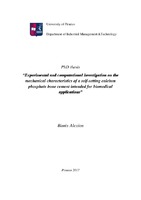| dc.description.abstractEN | In this work a thorough characterization of a calcium phosphate bone cement is presented, that was fabricated from the mixture of pure α-TCP powder and Na2HPO4 aqueous solution and subsequently hardened through hydrolysis reaction. The conducted characterization covers five main sections: detection of any occurred microstructural changes during hardening period, evaluation of the exhibited porosity, material’s mechanical testing, material’s absorbability in wet environment and the developed strains throughout characteristic phases of the material’s fabrication.
Moreover 2 simulation models are implemented and presented, in order to describe the diffusion phenomenon in wet environments and the induced hygroscopic strains, respectively. Additionally a case study was also simulated in which the use of the studied bone cement in a real life application is investigated. Based on the frame that is set from the abovementioned sections and implemented models, the structure of this thesis was accordingly formed and is described in the following paragraph, while a characteristic illustration can be found in Fig. 1.6. Initially, in Chapter 2 are reported several studies that set the context within the research falls, as far it concerns calcium phosphate bone cements. Afterwards, in Chapter 3, are presented the used materials and the implemented steps that were followed in order to fabricate the needed bone cement specimens. Moreover, the design and dimensions of the moulds that were used are also presented.
Chapter 4 is composed of 4 main sub-chapters that concern an equal number of the aforementioned main sections of the conducted characterization. Specifically, in the first one are reported the results from scanning electron microscopy (SEM) and X-ray diffractometry (XRD) in samples that were hardened at different levels, in order to investigate the development of any crystal structures during hardening period. The second sub-section concerns the evaluation of the material’s porosity with 3 different methods: micro computed tomography (μ-CT), microscopy investigation and confocal microscopy. In the third one the material properties of the examined biocement are determined from the conduction of compressive and diametral compressive testing, as well as from low-load indentations. Furthermore, based on the presented results a failure model is proposed. In the last sub-chapter of Chapter 4 the material’s absorbability is investigated by conducting immersion experiments in bone cement samples, in liquid environments.
Passing to Chapter 5, the experimental results of the developed strains are presented and discussed, obtained throughout three characteristic stages during material’s fabrication: (i) solidification (ii) hardening and (iii) re-immersion. The experimental data were obtained with the use of non-destructive, optic method (Fiber Bragg Grating-FBG sensor), whose working principle is described in details at the start of the chapter. Furthermore, the strain results are also coupled with the experimental results presented in Chapter 4, in order to investigate any correlation between them.
Chapter 6 includes the implemented models and their results for the diffusion phenomenon, during re-immersion, and the corresponding developed hygroscopic strains. Also the input data and the obtained results are presented and discussed for a simulated case study in which the examined bone cement was used as a fixation mean of a stem implant, in a Total Hip Replacement (THR) case. Finally, in Chapter 7 are summarized the exported conclusions from this work and several ideas are proposed as future work, in order to further deepen the characterization of such materials. | el |



